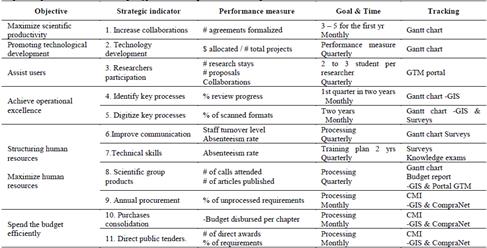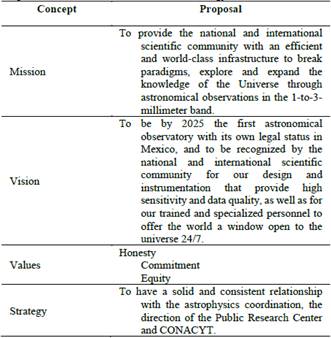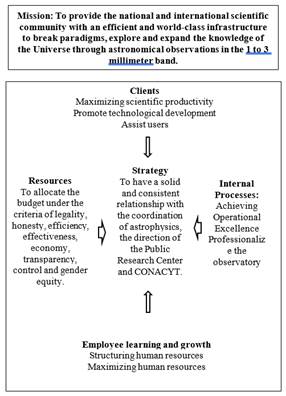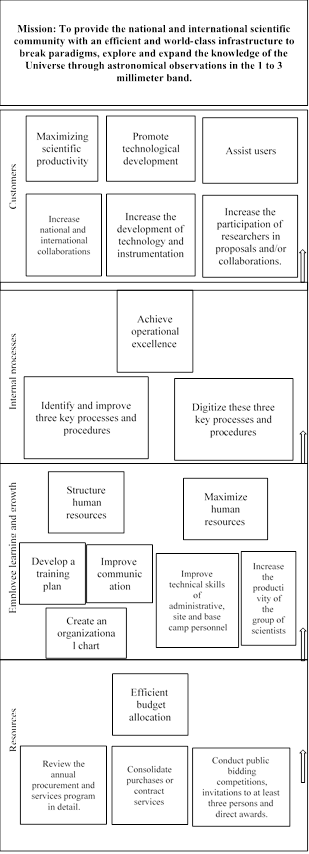1. Introduction
Since it assists in the management of enterprises by identifying key performance indicators that help achieve strategic objectives, the Balanced Scorecard (BSC) technique, developed by Robert Kaplan and David Norton in 1992, is recognized as a tool in strategic planning [1]. According to the reference [2], the BSC can be considered as a full management tool, a strategic management approach, a strategic management instrument, or a management philosophy. This managerial tool was originally developed for private, for-profit firms, but it has demonstrated that it may be functionally adapted for different types of organizations based on their sector, objective, and vision [6]. As a result, it was quickly embraced by government and nonprofit organizations in the United States, and by the 1990s, it had been adopted by a large number of organizations around the globe [7].
Implementing a BSC in the public sector has the following benefits, to name a few: Aligning organizational/unit priorities with the priorities of its various stakeholders (governments, citizens, etc.), demonstrating the value of programs to citizens, developing meaningful performance measures to determine program outcomes, connecting mission and vision to budget request, and determining the outcomes of the BSC implementation are all examples of alignment between mission, strategy, processes, and individual performance. According to reference [9], it is possible to transfer cutting-edge methods for strategic planning from private businesses to the public sector if the appropriate adjustments are made in connection to the goals and objectives of the organizations. One such method is the BSC. Changes to the customer perspective approach to the BSC are significant since citizens and contributors provide the financial resources and can be positioned at the top of a strategy map [10].
Initiatives to modernize the Mexican government's administration have been implemented during Miguel de la Madrid's presidency (1982-1988). The Ernesto Zedillo administration's Public Government Modernization Program 1995-2000, however, was one of the most important developments in the management of public companies. The program's main objective, according to reference [11], was to improve management and quality in the provision of public services by the adoption of private "managerialism" methods that took strategic planning, a quality-focused strategy, and process reengineering into account.
Public administration agencies, parastatal entities, higher education institutions, and public research centers, among others, have implemented strategic knowledge formulation to execute organizational management in line with international requirements into the financial and operational areas [12]. However, there aren't many case studies or publications on public educational institutions with established departmental or general strategic planning processes [13]. According to [13], strategic planning presents a challenge as well as a significant opportunity because it is regarded as a discipline with significant implications for the field of education and is supported by tools like the BSC for planning procedures, comprehensive management, and implementation in institutions.
This applied study was done to create a BSC proposal for the Large Millimeter Telescope Alfonso Serrano Astronomical Observatory in a Public Research Center (CPI). Using the method Niven recommended for public and nonprofit organizations in 2008, the objective is to apply the BSC in the aforementioned public research center by establishing the crucial strategic components-mission, values, and vision-as well as a strategic map and performance indicators.
2. Background and theoretical framework
2.1. A strategic planning
According to the source [13], strategic planning is a structured, hierarchical process that connects the many components of the strategy or conceptualizes their interactions as "cause and effect" relationships [3]. People in charge of planning must first go through a systematized information process that aims to aid them in acquiring, analyzing, and utilising information [14] in order to define and choose strategic objectives to lower both uncertainty and risk.
Strategic planning, taken in its purest form, is a helpful body of knowledge that promotes the adoption of diverse strategies and calls for the managers' time and commitment, expertise and understanding of the external environment, and a wide range of resources [15]. Strategic planning is a management and a leadership tool. The first one challenges decision-makers to ask themselves, "Am I acting morally?" whereas the second one evaluates that question [16].
2.2. Performance management transitions from measurement
The economy, industry, and technology-as well as society-have evolved and progressed at an exponential rate since the First Industrial Revolution. Processes and procedures are always being improved as a result of the greater competitiveness among businesses brought on by this development. This is how corporations have accepted the notion that "What is not defined cannot be measured" in order to improve and broaden their capabilities. If something is not measured, it cannot be improved. If something isn't fixed, it always gets worse [17]. As a result, systems, techniques, approaches, models, and other instruments have been developed to aid with and facilitate performance measurement, among other things.
Since the 1980s, performance measurement has made substantial structural advancements as "it has moved from measurement (i.e., what to measure, how to measure, and how to report results) to management (i.e., how to use measures to manage organizational performance)" [18,19].
The concept of performance management in public organizations also takes into account the accomplishment of the organizational mission, values, vision, and strategy while resources, processes, objectives, and impact are delegated to them in order to achieve the optimization of economic, efficiency, effectiveness, quality, and efficacy factors [21]. According to Reference [22], managing public administration requires managing a chain of inputs and outputs of activities between various levels of institutions and citizens. To manage public administration effectively, one must comprehend two characteristics: (1) the ability to facilitate rather than supply; and (2) its cross-sectoral nature.
2.3. Public and nonprofit organizations' balanced scorecards
Management requires the identification and selection of important metrics in order to effectively measure and oversee all organizational areas and operations [23]. The BSC has demonstrated to be a comprehensive framework and tool that successfully translates the mission, values, vision, and corporate strategy, providing decision-makers with "strategic objectives in a coherent set of performance measures" that communicate priority to all levels of the business [23,3]. The BSC considers the following four qualities: It is forward-looking, incorporates both internal and external metrics, and is most critical measure-focused [23]. It reflects the mission and strategy from the top down. It also provides answers to three fundamental questions, including how to set one's perspective apart from that of other stakeholders, what each perspective's key success factors are, and what metrics may be used to determine whether the strategy, purpose, vision, and values are being upheld [23].
The four components of the BSC are customers, money, internal processes, employee learning and advancement, and internal procedures. The perspectives (internal processes, learning and growth perspectives, consumer and financial perspectives) generate a balance since they consider both internal and exterior information [23]. In order to strengthen the organization's capabilities and concentrate efforts on working in harmony, objectives and metrics based on financial and non-financial data that demonstrate "cause and effect relationships in a profitable strategy" are incorporated into each perspective [24]. Its objective is to create a relationship between the organization, stakeholders, and society that is advantageous to all parties, enabling the creation of value and the accomplishment of strategy [3]. The BSC supports the development of multidisciplinary teams, knowledge networks, and strategic maps [25] and encourages organizational alignment.
Public and nonprofit organizations still have distinctive qualities that produce six different types of barriers, including oversight, strategy, transparency, trade-offs, causal linkages, and integrated issues, despite how easily the BSC can be modified to meet the needs of private organizations [26]. Each of these challenges must be conquered collaboratively in order for the BSC to be adopted successfully, and the kind of leadership an organization has will be its strongest enabler. Representatives of public organizations need to master the capacity to formulate a clear mission, vision, strategy, and set of values. In order to motivate employee performance without utilizing financial incentives, they also need to understand how to manage diverse work teams that are scattered around their own organization and among many stakeholders. They must answer to a variety of stakeholders, including other public organizations and governments, the press, citizens, among others, because their missions are related to initiatives like poverty reduction or job creation, where results may not be seen for decades and call for cross-cutting collaboration of various organizations.
2.4. SWOT analysis
The SWOT matrix is a commonly used strategic tool that may be built at many levels of hierarchy and in various fields, allowing study of factors that have an impact on a company both domestically and internationally. It entails performing a diagnosis of both the internal (Strengths and Weaknesses) and external (Opportunities and Threats) environments in order to identify the necessary actions to be taken as well as where to direct the resources and capabilities needed to use strengths to take advantage of opportunities, overcome weaknesses by taking advantage of opportunities, use strengths to avoid threats, and reduce weaknesses and avoid threats [27]. The formation of strategies will be made possible by properly analyzing and fusing each quadrant, which will ease the process of strategic planning and the operation of the organization. Despite appearing to be a straightforward tool to construct and interpret, this is important to keep in mind.
2.5. Goals, purpose, values, and strategy
Every nonprofit organization and governmental body has a mission in place. The motivation of the company's founders comes from a dedication to or a desire to provide a great good or service that meets a need and is advantageous to society. The four guiding elements of this goal-mission, values, vision, and strategy-are thought of as the foundation and soul of organizations [25,3]. They are in responsibility of imparting the organization's "explicit ideology" and the motivation, passion, and commitment necessary for each member to do the responsibilities assigned. The chain of ideal combinations that make up the organization's DNA and allow it to function, including the mission, values, vision, and strategy, are its constituent parts [25].
2.6. Strategic map
The strategy map [3] depicts graphically the pathway made up of viewpoints, objectives, and indicators that results in the application of the strategy and the growth of the organization's mission. Through the use of objectives, indicators, and metrics that promote organizational balance, it is a tool that enables the schematic visualization of the process used for building the strategy [25].
The strategy map is a tool that promotes internal collaboration and self-evaluation [28]. It is helpful to categorize and prioritize the steps that must be taken to successfully complete the mission. You should also establish standards to check that these steps are being carried out in a way that is consistent with the organization's values. The ease of management, transparency, and internal and external communication is the last benefit.
3. Methodology
3.1. Determine your mission, vision, values, and strategy
The purpose, values, and vision of the organization have been established since they are the fundamental ideas that guide its members in carrying out its many procedures and operations and inspiring and winning the trust of its numerous stakeholders [3]. This is the first stage of employing a BSC to successfully implement the overall strategy. Finally, these concepts can be transformed into metrics that will help the company manage its operations successfully. The organization's mission, values, and vision are the fundamental ideas that guide its members in the many processes and activities while aiming to arouse and cultivate trust in the minds of the various stakeholders, according to Reference [3]. This is the first stage of employing a BSC to successfully implement the overall strategy. Finally, these concepts can be transformed into metrics that will help the company manage its operations successfully.
Mission: In the absence of a mission statement for the astronomical observatory, a proposal was created utilizing the "5 whys and 6 questions" questionnaire Collins and Porras proposed in 1996 (Table 1). The analysis of the responses from the numerous interviews was used to develop a mind map for the proposal. The four criteria of long-term, encouraging change, simplicity and clarity, and ease of communication were also intended to be adhered to [3].
Vision: The vision was developed using the "10 key questions" questionnaire technique proposed by Allison and Kaye in 1997 (Table 1). The method consisted of seven steps: the initial outline, the coalition stage, the duration, and the outcome.
Values: Collins' 1999 "6 questions" questionnaire used as the assessment method. The examination of the replies yielded the value proposition listed below (Table 1).
Approach: The "5 key questions" questionnaire tool created by Kaplan and Norton in 2001 was used for this development as a part of the six-step process (how to start, conduct an environmental scan, identify who and what the stakeholders are, conduct a SWOT analysis, identify the strategic problem, and develop strategies) (Table 1).
4. Experiments and Results
4.1. Identification of Balanced Scorecard Perspectives
Based on the analysis of the SWOT matrix and proposals for mission, values, vision and strategy, we proceeded to identify the perspectives of the BSC proposal (Fig. 1) according to the method for public and non-profit organizations [3].
4.2. Strategy map analysis
Based on the information gathered from the mission and strategy proposals, together with the participation of the key members of the observatory, the following proposal for a strategic map is presented (Fig. 2.).
4.3. Performance measures proposal
The definition of performance indicators, as discussed in section 2.6, is essential for monitoring the objectives, but it is also required to pair them with a performance measure to ascertain if they were actually attained or, if not, to calculate the percentage of progress. As a result, the objectives that were chosen, along with their corresponding target, kind of follow-up, and tool, are shown in Table 2 along with a brief description and the accompanying recommendation for performance measurements.
Building a cathedral required a lot of people with specialized knowledge, money, and time, according to reference [29], just like launching a spaceship did. Since its construction was authorized in 1994, it took until December 2017 for its primary mirror to become 100% active. It is possible that as technology develops and potential changes or unfortunate events occur, but there are a number of important factors that may have contributed to the delay, including operational difficulties, a lack of resources, or construction-related delays. Among these components are control, monitoring, the use of best practices, strategic planning, and transparency.The BSC plan states that these important components are meant to work in the observatory's benefit. The observatory's implicitly developed mission, values, vision, and general strategy served as a strong foundation from which the strategic map, strategic objectives, and performance metrics required of every BSC could be developed.
A cause-and-effect link is established by all of the observatory's operations [3]. Even if there are numerous management techniques, systems, and technologies that support the organizational effort, the BSC could simply adjust its structure to the observatory's demands and convey the scenario it is in right now and where it wishes to see itself in the future for the collaborators. The key players were more willing, participative, and collaborative once they understood the overall goal, the required steps, and the anticipated outcomes, i.e., once they had a direction and a road map, when the BSC method was implemented in a public and nonprofit organization.[5].
Similar to this, it was highlighted that because of the observatory's unique circumstances and frequent environmental changes, strategic planning is even more crucial. This is so that the observatory, which is a public and nonprofit organization that depends on the political, economic, and social stability of a nation as well as federal funding, can show that it makes effective use of all of its resources and that the outcomes it produces are beneficial to stakeholders and society.
5. Conclusions
Building a cathedral required a lot of people with specialized knowledge, money, and time, according to the reference [29], just like launching a spaceship did. Since its construction was authorized in 1994, it took until December 2017 for its primary mirror to reach 100% activity, and it is possible that as technology develops and potential changes or unfortunate events occur, there are a number of important factors that will make that, despite the delay, whether in construction, a lack of resources, or operational issues, the willingness of stakeholders to work together, Among these components are control, monitoring, the use of best practices, strategic planning, and openness. According to the BSC proposal, these important components are meant to work in the observatory's benefit. However, in order to achieve this goal, a strong foundation consisting of the observatory's implicitly developed mission, values, vision, and general strategy was essential. From this foundation, it was possible to create the strategic map, strategic objectives, and performance metrics required of every BSC.
Table 2 Proposal of performance measures, target, type of monitoring and tool for strategic indicators.

Source: Own elaboration based on information provided by the administrative staff of the astronomical observatory.
All of the observatory's operations establish a cause-and-effect connection [3]. Even if there are numerous management techniques, systems, and technologies that support the organizational effort, the BSC could simply adjust its structure to the observatory's demands and convey the state it is in today and where it wishes to see itself in the future for the collaborators. The key players were more willing, participative, and collaborative once they understood the overall goal, the required steps, and the anticipated outcomes, i.e., they had a direction and a road map, but implementing the BSC method in a public and nonprofit organization proved to create a positive synergy from start to finish [30].
Similar to this, it was highlighted that because of the observatory's unique circumstances and the quick changes in its surroundings, strategic planning is much more crucial. This is because the observatory is a public and nonprofit organization that depends on the political, economic, and social stability of a nation as well as federal funding, and as such, it must prove and demonstrate that it uses all of its resources effectively in addition to presenting favorable results to stakeholders and society.


















